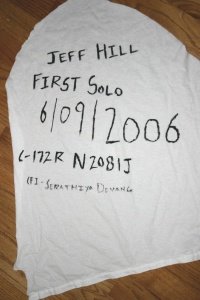| Lesson 19 - Solo 2 | |
| Flight time logged: | 1.6 hours |
| Total flight time logged: | 26.9 hours |
| Total takeoffs/landings: | 103 |
| Solo time: | 0.6 hours |
| Total time solo: | 1.6 hours |
| Total cost to date: | $4452 |
Today was a little cooler than last week, but it was still hot at 90 degrees. The wind was out of the NW at 10 knots. Luckily, there were no gusts. I flew my instructor over to Winder to practice a few touch-and-goes with short and soft takeoffs and landings. I believe I'll just have to get use to this bumpy air because it seems to always be bumpy every time I fly. I don't mind the up and down movement of the airplane. That doesn't bother me. It's the rolling that bothers me. I don't like when one wing gets pushed up unexpectedly by a thermal or gust of wind. I guess it takes experience to get use to flying in these conditions.
After Winder, I flew my instructor back to the flight school, dropped him off, and then proceeded back out to do some touch-and-goes at LZU solo. This was the first time I soloed at LZU. LZU has a tower and a lot more traffic than Winder. At one time, I was number four in line to land. I also had to extend my downwind due to a Learjet coming in to land. I slowed the plane down just as my instructor taught me so that I would not extend the downwind too far out. After seeing the Learjet pass me on final. I turned onto base keeping in mind that I need to stay above the jet's flight path to avoid wake turbulence. As I turned final, I aimed for a point just in front of where the Learjet touched down.
After three touch-and-goes, I taxied back to the school. I knew that I needed to get back to work since I was on a project deadline and did not want to be thinking of that while flying. Not to mention, it was past my lunchtime and I was getting hungry. :-)
I flew solo for 0.6 hours of the 1.6 hours today. I am supposed to fly solo to Winder tomorrow and practice short field landings there. My instructor wants me to get in 1.5 hours of solo time tomorrow. I'm hoping for good weather, light winds, and a not-so-bumpy flight.
After I return, we are going to put together a nav log for my first short cross-country flight. It is tentatively scheduled for July 5. I'll be flying south to Baldwin County airport in Milledgeville. My instructor will be with me for this flight, but I'll have to do the same flight solo in the near future.


